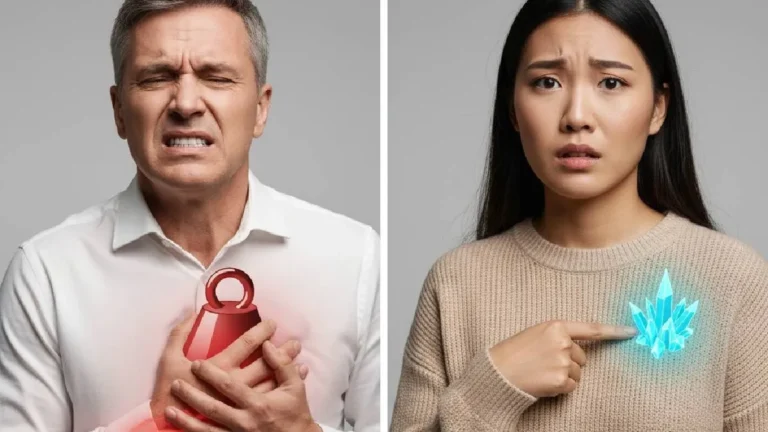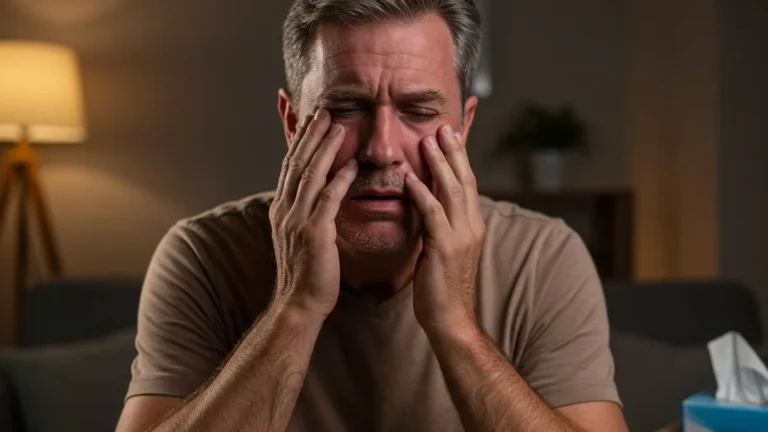Specific symptoms depend on the type of cancer.
Cancer symptoms vary depending on the type of cancer. This disease can cause many different symptoms, some more subtle than others. Here is a non-exhaustive list of the most common cancers and their symptoms:
Breast cancer
Most new cases of breast cancer are asymptomatic. At an advanced stage, the disease may present with a combination of symptoms such as:
- mass in the breast;
- change in breast size or shape;
- nipple discharge;
- redness or dimpling on the breast skin;
- etc.
Colon cancer
Common symptoms of colorectal cancer include:
- constipation that has recently appeared or is getting worse;
- persistent diarrhea;
- presence of blood in the stool;
- nausea and vomiting;
- urgent need to go to the toilet;
- sensation of incomplete evacuation of the rectum and impression that the rectum is always full;
- abdominal pain or cramps;
- unexplained weight loss;
- etc.
Lung cancer
Early symptoms of lung cancer may be mild or considered common breathing problems, delaying diagnosis. Common symptoms include:
- persistent cough;
- persistent difficulty breathing;
- abnormal chest pain;
- bloody sputum;
- voice modification;
- persistence of symptoms after treatment with antibiotics;
- etc.
Skin cancer (melanoma)
Symptoms of melanoma can be easily detected using the ABCDE rule:
- A for Asymmetry: a mole that is neither round nor oval, and whose colors and reliefs are not regularly distributed around its center ;
- B for Ragged Edges: jagged, poorly defined edges ;
- C as in Non-homogeneous color: disordered presence of several colors (black, blue, brown, red, or white);
- D for Increasing Diameter: a lesion likely to be a melanoma is generally larger than 6 mm ;
- E for Evolution: rapid change in size, shape, color, or thickness.
Prostate cancer
Prostate cancer usually doesn’t cause symptoms early in its development. As the prostate grows, people with prostate cancer experience:
- frequent need to urinate (frequent urination);
- difficulty urinating;
- blood in urine or semen;
- lower back or pelvic pain;
- urinary leaks;
- urinary tract infection ( cystitis, prostatitis, pyelonephritis);
- difficulty having an erection or pain during ejaculation.
General symptoms of cancer
Although each type of cancer has specific symptoms, some general signs can alert you to the presence of potential cancer. It is important to note that these signs do not necessarily mean that you have cancer, but they do warrant medical attention. Common symptoms to watch for include:
- unexplained weight loss;
- fatigue ;
- night sweats;
- loss of appetite;
- new and prolonged pain;
- vision or hearing problems;
- Recurring nausea or vomiting;
- blood in the urine;
- blood in the stool (visible or detectable by laboratory tests);
- recent change in intestinal transit (constipation or diarrhea);
- abnormal vaginal bleeding, especially after menopause;
- recurrent fever;
- chronic cough;
- changes in the size or color of a mole or changes in a skin ulcer that does not heal;
- growth or mark on the skin that enlarges or changes in appearance;
- lesion that does not heal;
- enlarged lymph nodes.
Cancer: When to see a doctor?
Anyone who experiences any of the above symptoms persistently or unexplainedly is advised to consult a healthcare professional. They can ask questions about the symptoms, review their medical history, and may order tests to better understand what is happening in the patient’s body.
Cancer screening methods
Diagnostic tests are performed when a doctor suspects cancer in a patient. The screening tests performed depend on the type of cancer.
In addition to observing symptoms, regular screening plays a key role in the early detection of many cancers, even before symptoms appear. Some cancers, such as breast cancer, colorectal cancer, and prostate cancer, have established screening programs.
Breast cancer screening
Mammography is an essential test for detecting breast tumors before they are palpable. In France, screening is recommended every two years for women aged 50 to 74, but women at risk can be monitored earlier.
Colorectal cancer screening
A stool immunoassay test is offered every two years to people aged 50 to 74. If the test is positive, a colonoscopy is performed to confirm the presence of polyps or tumors.
Prostate cancer screening
In men, prostate cancer screening consists of a digital rectal examination and prostate-specific antigen (PSA) levels. It is recommended for men aged 50 or earlier, if they are at increased risk.
Cervical cancer screening
A cervical smear, or cervical cancer screening test, detects precancerous cells. It is recommended for women between the ages of 25 and 65, every 3 to 5 years, according to guidelines.
However, even though these screening tests can save lives, there are often problems associated with them, such as false negatives: results showing no signs of cancer, when there is indeed one.
- False positives: results suggesting the presence of cancer when in fact it is not.
This is the case for prostate cancer screening, where we encounter many false positives, which leads to more invasive examinations, such as a prostate biopsy.
Other tests may be considered for other types of cancer:
- Lung CT: for lung cancer screening ;
- Regular self-examination: recommended in particular for early detection of testicular cancer.
Cancer diagnosis
Cancer is suspected based on a person’s symptoms, clinical examination results, and sometimes screening test results. Diagnosis is confirmed using:
- Imaging tests: X-ray, ultrasound, computed tomography (CT), MRI, etc..
- biopsy: a piece of the tumor is removed to look for cancer cells;
Good to know: Except for prostate cancer and PSA testing, tumor marker testing is not used for diagnosis, but to monitor progress once the diagnosis has already been made.
Determining the stage of cancer
When a cancer is diagnosed, determining the stage allows us to assess its degree of progression using the following criteria:
- its dimensions;
- Its location;
- its growth in neighboring structures;
- It’s spread to other parts of the body.
This determination also allows specialists to choose the most effective treatment and establish the prognosis. Staging is done using imaging tests such as:
- scintigraphy;
- X-ray;
- CT scan;
- MRI;
- bone scintigraphy with radioactive material;
- positron emission tomography (PET).
The choice of diagnostic test(s) depends on the type of cancer. In addition to imaging tests, doctors also use blood tests to clarify whether the cancer has started to affect other parts of the body, such as the liver, bones, or kidneys.
Cancer treatment
Cancer treatment depends on the type of cancer, its stage, and the patient’s overall health. Treatment options are often combined to maximize the chances of success. The main approaches to cancer treatment are:
- Surgery: This allows the tumor to be removed.
- Chemotherapy uses drugs to destroy cancer cells.
- Radiotherapy: This uses rays to target and eliminate diseased cells.
Other treatments, such as immunotherapy or targeted therapies, harness the immune system or specific biological mechanisms to attack cancer. Supportive care aimed at mitigating side effects and improving quality of life is also essential in overall cancer management.
Cancer prevention
Adopting a healthy lifestyle is one of the best strategies to reduce the risk of developing cancer. Here are some key things to consider:
- Balanced diet: A diet rich in fruits, vegetables, and fiber is necessary to prevent certain cancers, particularly those of the colon, breast, and stomach. The antioxidants, vitamins, and minerals found in fruits and vegetables help protect cells from damage. It is recommended to reduce the consumption of processed foods, which are high in saturated fats, sugars, and additives. Favoring unprocessed, whole, and varied foods contributes to better nutritional balance and good cellular health.
- Regular physical activity: Regular physical activity not only helps maintain a healthy weight but also reduces the risk of developing certain cancers. Indeed, physical exercise helps regulate hormones, reduce inflammation, and strengthen the immune system. It is recommended to do at least 150 minutes of moderate exercise per week (brisk walking, cycling, swimming) to benefit from these protective effects.
- Smoking cessation: Tobacco is one of the main preventable risk factors for cancer. Smoking is directly responsible for many cancers, including those of the lungs, mouth, throat, bladder, and pancreas. Quitting smoking, even after several years, significantly reduces the risk of cancer and improves overall quality of life. Smoking cessation, with the help of a healthcare professional, nicotine replacement therapy, or behavioral therapies, is a major step forward in preventing these serious diseases.
- Reduce alcohol consumption: Excessive alcohol consumption is linked to an increased risk of liver, mouth, esophageal, and bowel cancers. Alcohol damages cells and promotes the development of cancer-causing mutations. To reduce this risk, it is recommended to limit alcohol consumption to one drink per day for women and two drinks per day for men, or to avoid it altogether when possible.
Furthermore, since some viruses are directly involved in the development of cancers, vaccines have been developed to prevent some of these infections, including:
- The human papillomavirus (HPV) vaccine: the human papillomavirus (HPV) is responsible for the majority of cervical cancers, but also for certain cancers of the throat, anus, and penis. The HPV vaccine protects against the highest-risk strains and is recommended for young girls and boys, ideally before the onset of sexual activity. This vaccine can prevent up to 90% of cervical cancers, in addition to protecting against other types of HPV-related cancers.
- Hepatitis B vaccine: Hepatitis B is a virus that can cause chronic liver infections and the risk of liver cancer (hepatocellular carcinoma). The hepatitis B vaccine is recommended for newborns, children, and adults at risk of exposure to the virus. This vaccine is effective in preventing chronic infections and, therefore, in reducing the risk of liver cancer associated with this infection.























+ There are no comments
Add yours